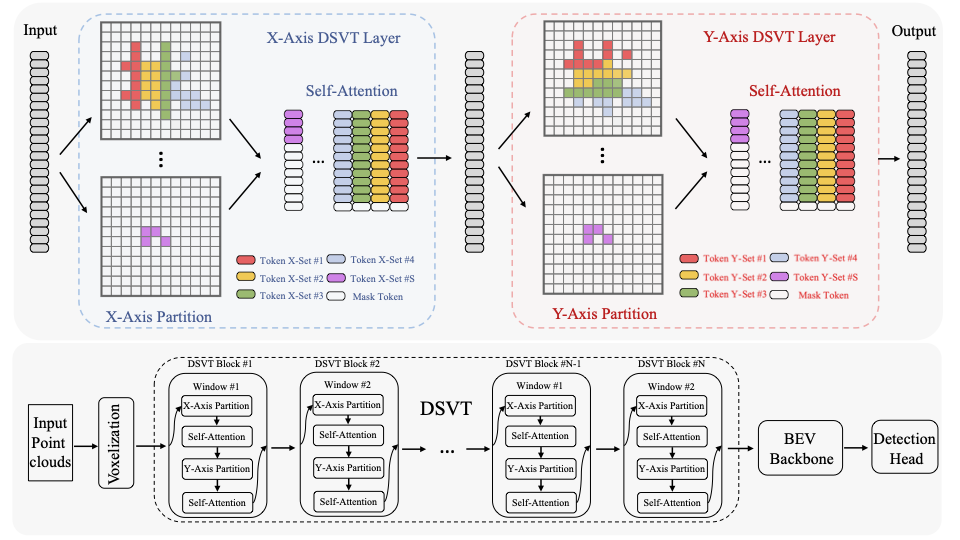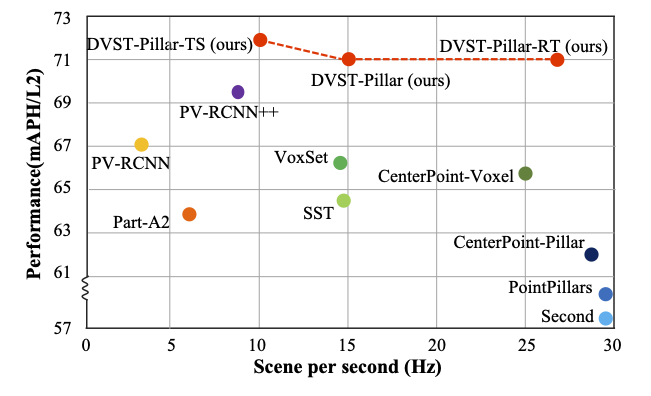This repo is the official implementation of: DSVT: Dynamic Sparse Voxel Transformer with Rotated Sets as well as the follow-ups. Our DSVT achieves state-of-the-art performance on large-scale Waymo Open Dataset with real-time inference speed (27Hz).
DSVT: Dynamic Sparse Voxel Transformer with Rotated Sets
Haiyang Wang*, Chen Shi*, Shaoshuai Shi
$^\dagger$ , Meng Lei, Sen Wang, Di He, Bernt Schiele, Liwei Wang$^\dagger$
- Primary contact: Haiyang Wang ( wanghaiyang6@stu.pku.edu.cn )
- [23-01-15] DSVT is released on arXiv.
- [23-02-28] 🔥 DSVT is accepted at CVPR 2023.
- [23-03-30] Code of Waymo is released.
- Release the arXiv version.
- SOTA performance of 3D object detection (Waymo & Nuscenes) and BEV Map Segmentation (Nuscenes).
- Clean up and release the code of Waymo.
- Release the Waymo Multi-Frames Configs.
- Release code of NuScenes.
- Merge DSVT to OpenPCDet.
Dynamic Sparse Voxel Transformer is an efficient yet deployment-friendly 3D transformer backbone for outdoor 3D object detection. It partitions a series of local regions in each window according to its sparsity and then computes the features of all regions in a fully parallel manner. Moreover, to allow the cross-set connection, it designs a rotated set partitioning strategy that alternates between two partitioning configurations in consecutive self-attention layers.
DSVT achieves state-of-the-art performance on large-scale Waymo one-sweeps 3D object detection (78.2 mAPH L1 and 72.1 mAPH L2 on one-stage setting) and (78.9 mAPH L1 and 72.8 mAPH L2 on two-stage setting), surpassing previous models by a large margin. Moreover, as for multiple sweeps setting ( 2, 3, 4 sweeps settings), our model reaches 74.6 mAPH L2, 75.0 mAPH L2 and 75.6 mAPH L2 in terms of one-stage framework and 75.1 mAPH L2, 75.5 mAPH L2 and 76.2 mAPH L2 on two-stage framework, which outperforms the previous best multi-frame methods with a large margin. Note that our model is not specifically designed for multi-frame detection, and only takes concatenated point clouds as input.
We provide the pillar and voxel 3D version of one-stage DSVT. The two-stage versions with CT3D are also listed below.
We run training for 3 times and report average metrics across all results. Regrettably, we are unable to provide the pre-trained model weights due to Waymo Dataset License Agreement. However, we can provide the training logs.
| Model | #Sweeps | mAP/H_L1 | mAP/H_L2 | Veh_L1 | Veh_L2 | Ped_L1 | Ped_L2 | Cyc_L1 | Cyc_L2 | Log |
|---|---|---|---|---|---|---|---|---|---|---|
| DSVT(Pillar) | 1 | 79.5/77.1 | 73.2/71.0 | 79.3/78.8 | 70.9/70.5 | 82.8/77.0 | 75.2/69.8 | 76.4/75.4 | 73.6/72.7 | Log |
| DSVT(Voxel) | 1 | 80.3/78.2 | 74.0/72.1 | 79.7/79.3 | 71.4/71.0 | 83.7/78.9 | 76.1/71.5 | 77.5/76.5 | 74.6/73.7 | Log |
| DSVT(Pillar-TS) | 1 | 80.6/78.2 | 74.3/72.1 | 80.2/79.7 | 72.0/71.6 | 83.7/78.0 | 76.1/70.7 | 77.8/76.8 | 74.9/73.9 | Log |
| DSVT(Voxel-TS) | 1 | 81.1/78.9 | 74.8/72.8 | 80.4/79.9 | 72.2/71.8 | 84.2/79.3 | 76.5/71.8 | 78.6/77.6 | 75.7/74.7 | Log |
| Model | #Sweeps | mAP/H_L1 | mAP/H_L2 | Veh_L1 | Veh_L2 | Ped_L1 | Ped_L2 | Cyc_L1 | Cyc_L2 | Log |
|---|---|---|---|---|---|---|---|---|---|---|
| DSVT(Pillar) | 2 | 81.4/79.8 | 75.4/73.9 | 80.8/80.3 | 72.7/72.3 | 84.5/81.3 | 77.2/74.1 | 78.8/77.9 | 76.3/75.4 | Log |
| DSVT(Voxel) | 2 | 81.9/80.4 | 76.0/74.6 | 81.1/80.6 | 73.0/72.6 | 84.9/81.7 | 77.8/74.8 | 79.8/78.9 | 77.3/76.4 | Log |
| DSVT(Pillar-TS) | 2 | 81.9/80.4 | 76.0/74.5 | 81.3/80.9 | 73.4/73.0 | 85.2/81.9 | 77.9/74.7 | 79.2/78.3 | 76.7/75.9 | Log |
| DSVT(Voxel-TS) | 2 | 82.3/80.8 | 76.6/75.1 | 81.4/81.0 | 73.5/73.1 | 85.4/82.2 | 78.4/75.3 | 80.2/79.3 | 77.8/76.9 | Log |
| Model | #Sweeps | mAP/H_L1 | mAP/H_L2 | Veh_L1 | Veh_L2 | Ped_L1 | Ped_L2 | Cyc_L1 | Cyc_L2 | Log |
|---|---|---|---|---|---|---|---|---|---|---|
| DSVT(Pillar) | 3 | 81.9/80.5 | 76.2/74.8 | 81.2/80.8 | 73.3/72.9 | 85.0/82.0 | 78.0/75.0 | 79.6/78.8 | 77.2/76.4 | Log |
| DSVT(Voxel) | 3 | 82.1/80.8 | 76.3/75.0 | 81.5/81.1 | 73.6/73.2 | 85.3/82.4 | 78.2/75.4 | 79.6/78.8 | 77.2/76.4 | Log |
| DSVT(Pillar-TS) | 3 | 82.5/81.0 | 76.7/75.4 | 81.8/81.3 | 74.0/73.6 | 85.6/82.6 | 78.5/75.6 | 80.1/79.2 | 77.7/76.9 | Log |
| DSVT(Voxel-TS) | 3 | 82.6/81.2 | 76.8/75.5 | 81.8/81.4 | 74.0/73.6 | 85.8/82.9 | 78.8/75.9 | 80.1/79.2 | 77.7/76.9 | Log |
| Model | #Sweeps | mAP/H_L1 | mAP/H_L2 | Veh_L1 | Veh_L2 | Ped_L1 | Ped_L2 | Cyc_L1 | Cyc_L2 | Log |
|---|---|---|---|---|---|---|---|---|---|---|
| DSVT(Pillar) | 4 | 82.5/81.0 | 76.7/75.3 | 81.7/81.2 | 73.8/73.4 | 85.4/82.3 | 78.5/75.5 | 80.3/79.4 | 77.9/77.1 | Log |
| DSVT(Voxel) | 4 | 82.6/81.3 | 76.9/75.6 | 81.8/81.4 | 74.1/73.6 | 85.6/82.8 | 78.6/75.9 | 80.4/79.6 | 78.1/77.3 | Log |
| DSVT(Pillar-TS) | 4 | 82.9/81.5 | 77.3/75.9 | 82.1/81.6 | 74.4/74.0 | 85.8/82.8 | 79.0/76.1 | 80.9/80.0 | 78.6/77.7 | Log |
| DSVT(Voxel-TS) | 4 | 83.1/81.7 | 77.5/76.2 | 82.1/81.6 | 74.5/74.1 | 86.0/83.2 | 79.1/76.4 | 81.1/80.3 | 78.8/78.0 | Log |
| Model | mAP | NDS | mATE | mASE | mAOE | mAVE | mAAE |
|---|---|---|---|---|---|---|---|
| DSVT(Pillar) | 66.4 | 71.1 | 27.0 | 24.8 | 27.2 | 22.6 | 18.9 |
| Model | mAP | NDS | mATE | mASE | mAOE | mAVE | mAAE | results |
|---|---|---|---|---|---|---|---|---|
| DSVT(Pillar) | 68.4 | 72.7 | 24.8 | 23.0 | 29.6 | 24.6 | 13.6 | result.json |
| Model | Drivable | Ped.Cross. | Walkway | StopLine | Carpark | Divider | mIoU |
|---|---|---|---|---|---|---|---|
| DSVT(Pillar) | 87.6 | 67.2 | 72.7 | 59.7 | 62.7 | 58.2 | 68.0 |
We present a comparison with other state-of-the-art methods on both inference speed and performance accuracy. After being deployed by NVIDIA TensorRT, our model can achieve a real-time running speed (27Hz).
| Model | Latency | mAP_L2 | mAPH_L2 |
|---|---|---|---|
| Centerpoint-Pillar | 35ms | 66.0 | 62.2 |
| Centerpoint-Voxel | 40ms | 68.2 | 65.8 |
| PV-RCNN++(center) | 113ms | 71.7 | 69.5 |
| DSVT(Pillar) | 67ms | 73.2 | 71.0 |
| DSVT(Voxel) | 97ms | 74.0 | 72.1 |
| DSVT(Pillar+TensorRt) | 37ms | 73.2 | 71.0 |
Please refer to INSTALL.md for installation.
Please follow the instructions from OpenPCDet. We adopt the same data generation process.
# multi-gpu training
cd tools
bash scripts/dist_train.sh 8 --cfg_file <CONFIG_FILE> --sync_bn [other optional arguments]
You can train the model with fp16 setting to save cuda memory, which may occasionally report gradient NaN error.
# fp16 training
cd tools
bash scripts/dist_train.sh 8 --cfg_file <CONFIG_FILE> --sync_bn --fp16 [other optional arguments]
# multi-gpu testing
cd tools
bash scripts/dist_test.sh 8 --cfg_file <CONFIG_FILE> --ckpt <CHECKPOINT_FILE>
- To cater to users with limited resources who require quick experimentation, we also provide results trained with a single frame of 20% data for 12 epoch on 8 RTX 3090 GPUs. The following is the variants of dimension(192).
- By setting the DSVT to dimension 128 and using fp16 training as mentioned above, you can further reduce CUDA memory usage and computational overhead. This may slightly reduce performance (-0.3 @mAPHL2), but it will significantly decrease training time and CUDA memory consumption.
| Performance@(20% Data for 12 epoch) | Batch Size | Training time | mAP/H_L1 | mAP/H_L2 | Veh_L1 | Veh_L2 | Ped_L1 | Ped_L2 | Cyc_L1 | Cyc_L2 | Log |
|---|---|---|---|---|---|---|---|---|---|---|---|
| DSVT(Pillar&Dim192) | 1 | ~5.5h | 75.3/72.4 | 69.3/66.4 | 75.3/74.8 | 66.9/66.4 | 79.4/71.7 | 71.7/64.6 | 71.9/70.8 | 69.2/68.1 | Log |
| DSVT(Voxel&Dim192) | 1 | ~6.5h | 76.2/73.6 | 69.9/67.4 | 75.7/75.2 | 67.2/66.8 | 80.1/73.7 | 72.5/66.4 | 72.8/71.8 | 70.1/69.1 | Log |
# example DSVT-P@fp32 ~5.5h on RTX3090
cd tools
bash scripts/dist_train.sh 8 --cfg_file ./cfgs/dsvt_models/dsvt_plain_D512e.yaml --sync_bn --logger_iter_interval 500
# example DSVT-P@fp16 ~4.0h on RTX3090
cd tools
bash scripts/dist_train.sh 8 --cfg_file ./cfgs/dsvt_models/dsvt_plain_D512e.yaml --sync_bn --fp16 --logger_iter_interval 500
- To reproduce the resutls in main paper, please refer the following configs. These results are trained on 8 NVIDIA A100 GPUs (40GB).
- If your computing resources are limited, try reducing batch size and the corresponding lr, such as BATCH_SIZE_PER_GPU = 1 and LR=0.001.
| Performance@(100% Data for 24 epoch) | Batch Size | Training time | mAP/H_L1 | mAP/H_L2 | Veh_L1 | Veh_L2 | Ped_L1 | Ped_L2 | Cyc_L1 | Cyc_L2 | Log |
|---|---|---|---|---|---|---|---|---|---|---|---|
| DSVT(Pillar) | 3 | ~22.5h | 79.5/77.1 | 73.2/71.0 | 79.3/78.8 | 70.9/70.5 | 82.8/77.0 | 75.2/69.8 | 76.4/75.4 | 73.6/72.7 | Log |
| DSVT(Voxel) | 3 | ~27.5h | 80.3/78.2 | 74.0/72.1 | 79.7/79.3 | 71.4/71.0 | 83.7/78.9 | 76.1/71.5 | 77.5/76.5 | 74.6/73.7 | Log |
# example DSVT-P@fp32 ~22.5h on NVIDIA A100
cd tools
bash scripts/dist_train.sh 8 --cfg_file ./cfgs/dsvt_models/dsvt_plain_1f_onestage.yaml.yaml --sync_bn --logger_iter_interval 500
- If you are limited by computation resource, please try to reduce the batch size and adopt fp16 training schemes.
- If your memory is limited, please turn off the USE_SHARED_MEMORY.
- If your training process takes up a lot of memory and the program starts slowly, please reduce the numba version to 0.48, as mentioned in INSTALL.md.
- If you encounter a gradient that becomes NaN during fp16 training, don't worry, it's normal. You can try a few more times.
- If you couldn’t find a solution, search open and closed issues in our github issues page here.
- If still no-luck, open a new issue in our github. Our turnaround is usually a couple of days.
Please consider citing our work as follows if it is helpful.
@inproceedings{wang2023dsvt,
title={DSVT: Dynamic Sparse Voxel Transformer with Rotated Sets},
author={Haiyang Wang, Chen Shi, Shaoshuai Shi, Meng Lei, Sen Wang, Di He, Bernt Schiele and Liwei Wang},
booktitle={CVPR},
year={2023}
}
DSVT uses code from a few open source repositories. Without the efforts of these folks (and their willingness to release their implementations), DSVT would not be possible. We thanks these authors for their efforts!
- Shaoshuai Shi: OpenPCDet
- Lue Fan: SST
- Tianwei Yin: CenterPoint
We would like to thank Lue Fan, Lihe Ding and Shaocong Dong for their helpful discussions. This project is partially supported by the National Key R&D Program of China (2022ZD0160302) and National Science Foundation of China (NSFC62276005).








